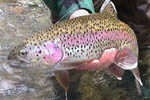|
|
|
The Flytier:
|
Story By:
Dennis Collier
Recipe By:
Dennis
Flies Tied By:
Dennis
Dennis' Home: Longmont,
CO
Dennis' Web site: http://www.dennis-collier.com
|
Dennis
fell in love with fly fishing as a young boy, while sitting on
a stream bank watching his father fly fish. His introduction
to fly tying also came at an early age, when Santa delivered
the well-remembered "Basic Fly Tying Kit" one Christmas.
That was over 40 years ago. Today, Dennis guides and
instructs in Colorado and enjoys sharing his many innovative
fly patterns. |
The Fly:
Basic SnowBall
Beetle. Photo by Peter Frailey
Hook:
TMC 3769, sizes 10 to 16
Thread: Black
3/0 Monocord
Body: Black 3mm thick
foam
Legs: Black small round rubber - strip
from sheet in pairs, split after tying
Indicator:
Dyed deer belly hair, tied butts first, flared with tight
thread wraps and cut to shape
Glue: Zap-A-Gap
Super Glue - small bead from bend of the eye to prevent foam from
rolling on shank
|
The Story:
|
SnowBalls in
Summer |
|
The birthplace of the SnoBall Beetle
lies in the flood plain of an ancient glacial moraine in Rocky
Mountain National Park. Through the picture-postcard valley flows
the headwaters of the Big Thompson River. Here the "Big-T" supports
a thriving all-wild trout population of predominantly brown
trout. 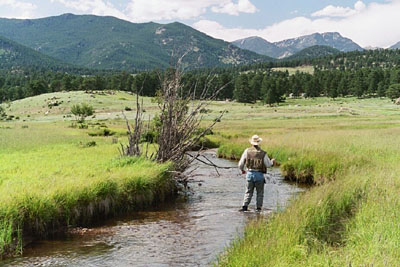
The Big-T offers plenty of challenge and spectacular
Rocky Mountain views
Ants and beetles make their spring
debut with the receding winter snowpack and quickly become a
significant portion of the food supply for these fish. As spring
becomes summer, knee-deep meadow grasses will briefly offer up their
banquet of hoppers as well. At 9,000 feet of elevation, major
aquatic insect hatches are sparse Ė this is terrestrial territory!
The SnoBall Beetle is a third cousin,
twice removed, from the notable Chernobyl Ant. As an avid fly tier I
subscribe to the theory; "If it ainít broke Ė fix it," and the
Chernobyl Ant was just begging to be tinkered with. Many variations
later (all extensively field-tested in my liquid laboratory) I
arrived at the SnoBall Beetle pattern as it appears today.
The name derives from the deer hair
"sight indicator". Tie the indicator in whatever colors you like Ė
white and fluorescent chartreuse work best for me and I carry both.
The white is more difficult to see if youíre fishing in heavy foam
lines, yellow and chartreuse really stand out in dim light-levels at
dawn and dusk.

Native Big-T brown
The SnoBall also makes an excellent
"strike indicator" when fished with a nymph dropper or small,
difficult to see, emerger patterns riding low in the surface film.
Last spring I was fishing one of the many ponds at Elktrout Lodge
near Kremmling, Colorado, with deep drifted midge pupaeís. After
having a few fish inhale my strike indicator as it floated on the
surface, I decided to put a hook in it. I swapped the cork indicator
for a #12 SnoBall Beetle and in minutes my rod was bending to the
strain of a large Donaldson Rainbow, beetle in jaw, headed for the
other side of the pond. As the morning sun warmed the water,
callibaetis mayflies began to dance on the liquid mirror. A size 14
parachute Adams replaced the midge pupae and a real comedy act
began. Big bows would sprint across the pond when the flies hit the
surface, then slam on the brakes and turn toward one fly, then the
other, trying to decide which bug to take first. They reminded me of
kids in a candy shop and the beetle won more than its fair share of
the decisions!
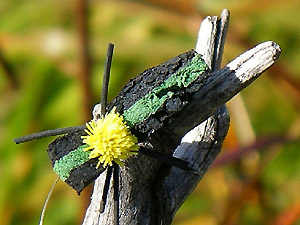
Well-chewed by Big-T browns
Dress this fly on 2X heavy wire, wet
fly hooks. The keel effect of the heavy wire helps the fly land in
the upright position. The heavy wire is also more bend-resistant for
those occasions when you catch overhanging grasses on your cast.
Give a good tug to free the fly. However, donít pick the freed fly
up and off the water when this happens. Many times the fly "jumping"
from the grass is just what it takes to trigger a strike. This will
be a frequent experience if youíre fishing the bug where it needs to
be fished Ė tight to the bank! This fly should land on the water
with a good Ďsplatí so delicate presentations normally arenít
required.
The SnoBall Beetle is a very simple
pattern to tie and offers exceptional durability. Youíll want to put
a drop of "Zap-A-Gap" super glue on the thread wraps when the fly is
finished to keep the foam from rolling on the hook shank. Next, the
"fifty-cent secret" - strip the round rubber legs off the sheet in
two (attached) strands at a time. Tie them directly to the side of
the foam in this (still attached) configuration, then separate and
trim upon completion. Itís this subtle detail that results in the
uniformly splayed legs.
In this part of the country, wind is
an almost constant factor while fishing. Consequently, I prefer 7Ĺ
foot "weight forward" leaders tapered to 3X. To this, Iíll add a
couple feet of 4X, fluorocarbon tippet. Weight forward leaders
really help turn over the fly and facilitate fly presentation while
casting into gentle 30-mph breezes. On flat water, where fish have
more time to examine and reject your offering, drop down to 5X if
necessary. Anything less is an invitation to break-off as fish tend
to take this fly in the same aggressive manner as hoppers.
Friends and fellow anglers have
reported fishing this creation on many of the Westís most demanding
and hard-fished waters. My good friend and fly tying mentor, Charlie
Craven, fished Coloradoís Frying Pan River with his oldest son this
past Fathers Day. His e-mail read: "donít bother fishing the ĎPaní
with a SnoBall Beetle, we just caught every fish in the river on the
thing!" Charlie is a fly designer for Umpuqa Feather Merchants,
co-creator of the BC Hopper - among other notable patterns - and one
of the finest young fly tiers and fishermen Iíve ever known. When he
gets excited about a fly, I take it to the bank. Iíve personally
fished the SnoBall Beetle on the Frying Pan during a major BWO
hatch, and caught numerous fish while my best "olive" patterns were
being rejected. Charlie offers this opinion: "it catches a lot of
fish because they havenít seen 10,000 other flies just like it that
day." Who knows best but the fish? I donít argue with success!
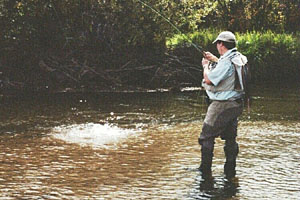
Charlie Craven shows how it's
done
Iím not a warm-water fisherman
myself, but acquaintances that pursue panfish on stillwaters suggest
tying the SnoBall Beetle with much longer legs to impart an enticing
action when "popping" the fly with a short, jerky retrieve.
Retaining the original design, different colors of foam and legs
also could be used to accommodate the discriminating pallets of your
local bluegill, bream and crappie friends.

Tied for my warmwater friends. Photo by Peter
Frailey
"Ever-Ready Beetle," "Timex Beetle,"
"Fifty-Fish-Fly," and "Fish-In-A-Barrel Fly" have affectionately
replaced the SnoBall Beetleís original namesake by many converts.
Call it what you like but tie and try a few on your favorite waters.
You might find throwing SnoBalls in Summer is just what the doctor
ordered.
--Dennis
Collier
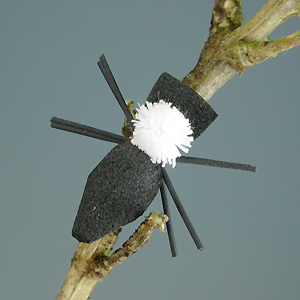
Photo
by Peter Frailey
|
|
copyright © Notice by fishingwithflies.com.
All rights reserved. This
material is for your personal enjoyment. Please obtain prior
written permission from the author and fishingwithflies.com
before any other
use. |
| |
